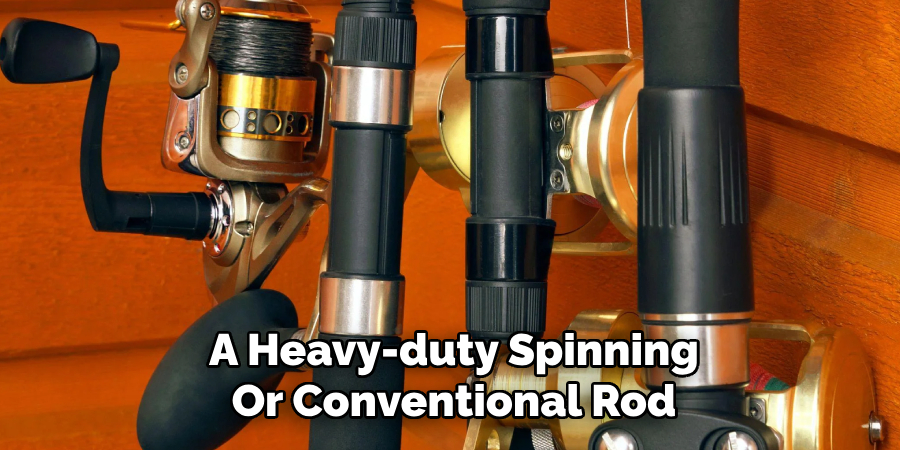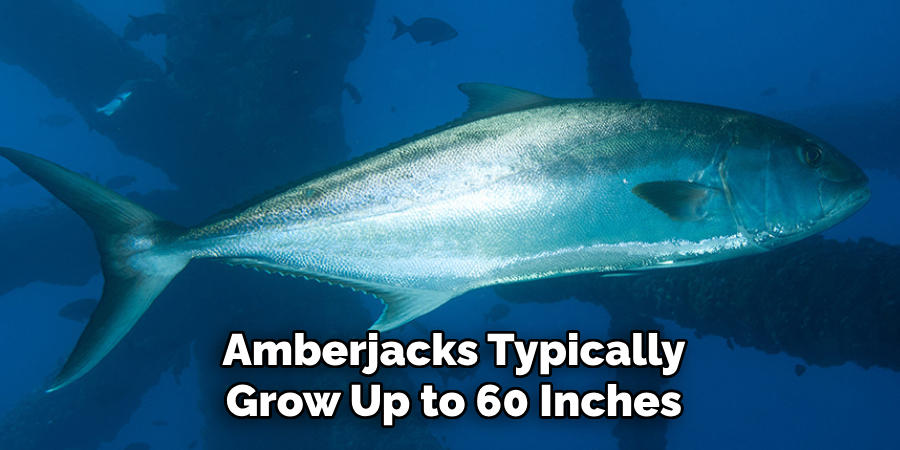Amberjack fishing is an exhilarating experience sought after by both novice and seasoned anglers. Known for their strength and agility, amberjacks put up a thrilling fight that tests fishing skills and patience. Found in both deep and shallow waters, these powerful fish often inhabit wrecks, reefs, and other underwater structures, making them a challenging and rewarding catch.

This guide on how to fish for amberjack will provide essential tips and techniques for successfully fishing for amberjack, ensuring a memorable experience on the water.
What is Amberjack?
First, it is important to understand what amberjacks are and their behavior. Amberjacks are a species of fish belonging to the Carangidae family, which includes other popular game fish such as tuna and mackerel. They are found in warm waters around the world, with different subspecies inhabiting different regions.
Amberjacks typically grow up to 60 inches in length and can weigh up to 150 pounds, making them a prized catch for sport fishermen. They are known for their powerful and quick swimming abilities, often diving deep into the water when hooked.
Essential Gear
Before heading out on an amberjack fishing trip, it is essential to have the right gear. Here are some important items you will need:
Fishing Rod:
A heavy-duty spinning or conventional rod with a strong backbone is recommended for handling the strength of an amberjack. A rod with a length of 6-7 feet and a medium to heavy power rating is ideal.

Reel:
A strong and reliable reel that can hold at least 300 yards of line is recommended for amberjack fishing. A conventional reel with a high gear ratio is preferred for quick retrieval.
Line:
A braided line with a minimum weight rating of 50 pounds is recommended for amberjack fishing. This will provide the strength needed to handle the fish’s powerful runs and prevent breakage.
Terminal Tackle:
For bait fishing, a strong circle hook in size 6/0 or larger is recommended. For lure fishing, heavy-duty jigs or topwater lures that mimic the prey of an amberjack are preferred.
8 Step-by-step Guidelines on How to Fish for Amberjack
Step 1: Locate Amberjack Hot Spots
Amberjacks are known to inhabit areas with underwater structures such as shipwrecks, reefs, oil rigs, and rocky ledges. These structures provide shelter and attract smaller fish, which amberjacks prey on. Use a fish finder or marine chart to identify these locations. Focus your search on depths ranging from 50 to 300 feet, as amberjacks are often found at varying depths depending on water temperature and time of year.
Keep in mind that early mornings and late afternoons are often the best times to find active amberjack near these hot spots. Patience and thorough scouting will be key to successfully locating their preferred habitat.
Step 2: Prepare Bait and Lures
Live bait is the most effective method for amberjack fishing. Some popular options include blue runners, goggle-eyes, and pinfish. If live bait is unavailable, fresh dead bait such as squid or mullet can also work well.

For lure fishing, heavy-duty jigs such as butterfly jigs or vertical speed jigs are recommended. These lures mimic the movements of an injured fish and can entice an amberjack to strike.
Step 3: Rigging Your Gear
When rigging your gear for amberjack fishing, it is essential to use strong knots and connections that can withstand the strength of these fish. A wire leader is recommended to prevent line breakage, as amberjacks have sharp teeth that can easily cut through monofilament or fluorocarbon lines.
You can also use a fish finder rig with a heavy sinker to keep the bait close to the bottom, where amberjack often feeds. Alternatively, you can use a topwater popper or surface lure for an exciting visual strike.
Step 4: Drop Your Bait
Once you have located your hot spot and have prepared your gear, it’s time to drop your bait into the water. Use caution when lowering live bait into the water as sudden movements may startle them and cause them to swim away. If using a jig or lure, slowly lower it down until it reaches the desired depth.
The key to successfully catching an amberjack is to keep your bait or lure close to the structure. These fish are known to hide in crevices and ambush their prey, so keeping your bait near the structure will increase your chances of a strike.
Step 5: Be Patient and Ready for Action
Amberjacks can be finicky biters, so patience is important when waiting for a strike. It may take several minutes before an amberjack takes interest in your bait, but be ready for a sudden and powerful strike. These fish are known for their aggressive fighting style, and it’s important to have a firm grip on your rod.

If using live bait, it’s essential to let the fish take the bait and run with it before setting the hook. If you feel a strike, wait a few seconds before setting the hook to ensure that the fish has taken the bait.
Step 6: Reel in Your Catch
Once you have successfully set the hook, be prepared for an intense fight. Amberjacks are known for their powerful runs and may try to dive deep into the water or wrap your line around structures. It’s important to keep constant pressure on the fish and use your rod’s strength to tire it out.
If using a conventional reel, use its high gear ratio to quickly retrieve the line when needed. Keeping steady tension on the line is crucial to prevent the fish from breaking off.
Step 7: Landing Your Catch
Once you have successfully reeled in your catch, it’s time to land the fish. It’s important to handle amberjacks with care as they can be dangerous when out of water. Use a landing net or gaff hook to bring the fish onto your boat.
If releasing the fish, handle it carefully and quickly return it to the water. If keeping the fish, bleed and gut it immediately after capture for optimal freshness.
Step 8: Stay Safe and Responsible
Fishing for amberjack can be an exhilarating experience, but it’s important to prioritize safety at all times. Keep a safe distance from other boats and structures, especially when reeling in a catch. Always wear proper safety gear and follow all local regulations and size limits.
As responsible anglers, it’s also important to practice sustainable fishing habits by not taking more than your share of the population and properly disposing of any trash or debris while on the water.
Following these guidelines on how to fish for amberjack and respecting the environment will ensure a successful and enjoyable amberjack fishing experience. So, be prepared, patient, and responsible for an unforgettable day on the water!
Additional Tips
- Use high-quality and well-maintained gear to increase your chances of successfully catching an amberjack.
- When fishing in deeper waters, consider using a downrigger or planer to keep your bait at the desired depth.
- Stay vigilant and observe any changes in water temperature or behavior of baitfish, as these can indicate the presence of amberjacks.
- Consider hiring a professional guide who is familiar with local hot spots and techniques for catching amberjack.
- If releasing a fish, ensure that it has fully recovered before releasing it back into the water. Avoid dragging or handling the fish too much to prevent stress or injury.
- Always have a first aid kit and know how to properly handle any injuries that may occur while fishing. Overall, be prepared for any situation that may arise on the water.

Frequently Asked Questions
Q: What is the Best Time of Day to Fish for Amberjack?
A: Early mornings and late afternoons are often the most productive times for amberjack fishing. However, it’s important to scout out potential hot spots and vary your fishing time depending on water temperature and seasonal patterns.
Q: What Type of Gear is Needed for Amberjack Fishing?
A: Heavy-duty gear is recommended for amberjack fishing, including a medium to heavy action rod, strong conventional or spinning reel with high line capacity, wire leader, and sturdy terminal tackle. It’s also important to have proper safety gear and tools such as a landing net or gaff hook.
Q: Are There Any Size Limits or Regulations for Catching Amberjack?
A: Yes, there are size limits and regulations in place for catching amberjack. These can vary by location, so it’s essential to check local regulations before heading out on the water. As responsible anglers, it’s important to adhere to these limits for the sustainability of the amberjack population.
Q: What is the Best Bait for Amberjack Fishing?
A: Live bait is recommended for amberjack fishing, with popular options including blue runners, goggle-eyes, and pinfish. If live bait is unavailable, fresh dead bait such as squid or mullet can also be effective. For lure fishing, heavy-duty jigs such as butterfly jigs or vertical speed jigs are recommended.
Q: What Techniques Can Be Used When Fishing for Amberjack?
A: While live bait and jigging are the most common techniques used when targeting amberjack, topwater lures and poppers can also be effective for visual strikes. Vertical jigging, slow trolling, and drifting near structures are other techniques that can yield successful catches. It’s important to vary your techniques and bait selection based on the behavior of the fish.
Conclusion
Amberjack fishing is an exciting and challenging activity that requires patience, skill, and the right gear. By following these guidelines on how to fish for amberjack, you can increase your chances of successfully catching this powerful fish.
Remember to always prioritize safety and respect for the environment while enjoying this thrilling sport! So get out there, explore different hot spots, try different techniques, and have fun reeling in these impressive fish. Happy fishing!
About the Author
Jennifer Branett is the author of Fishy Kayak and an expert in fish-related fields, with over 10 years of experience. Her work blends passion for fishing with a commitment to conservation.
Educational Background
Degree: Bachelor’s in Marine Biology
Institution: University of California, Santa Barbara
Specializations: Aquatic ecosystems, fish behavior, and sustainable practices
Professional Experience
Conservation Projects:
Collaborated with local organizations to restore aquatic habitats
Developed educational programs on sustainable fishing practices
Publications:
Authored articles for fishing magazines and environmental journals
Featured speaker at fishing expos and conservation conferences
Key Areas of Expertise
Fishing Techniques:
Kayak fishing strategies
Freshwater and saltwater fishing methods
Environmental Stewardship:
Advocacy for sustainable fishing
Promoting biodiversity in aquatic environments
Awards and Recognition
Recipient of the [Specific Award Name] for contributions to marine conservation
Recognized as a leading voice in the fishing community by [Organization/Publication Name]
Community Engagement
Workshops and Seminars:
Regularly hosts events to educate anglers on sustainable practices
Engages with youth programs to inspire the next generation of fishers
Online Presence:
Maintains an active blog sharing tips, stories, and conservation efforts
Engages with followers on social media to promote fishing ethics
Personal Interests
Enjoys kayaking in scenic locations
Passionate about photography, capturing the beauty of nature
Advocates for local conservation efforts in her community
